If you like it, share it. Thanks! (Corrections welcome)
 Thank you to everybody who has made this article possible.
Thank you to everybody who has made this article possible.
 During the Cold War the USS Halibut was modified for 'Underwater Engineering', a euphemism for covert intelligence gathering operations. Because her missions were kept Top Secret, photo or illustrations of her modifications are virtually non-existent. In particular, the configuration below the waterline.
During the Cold War the USS Halibut was modified for 'Underwater Engineering', a euphemism for covert intelligence gathering operations. Because her missions were kept Top Secret, photo or illustrations of her modifications are virtually non-existent. In particular, the configuration below the waterline.
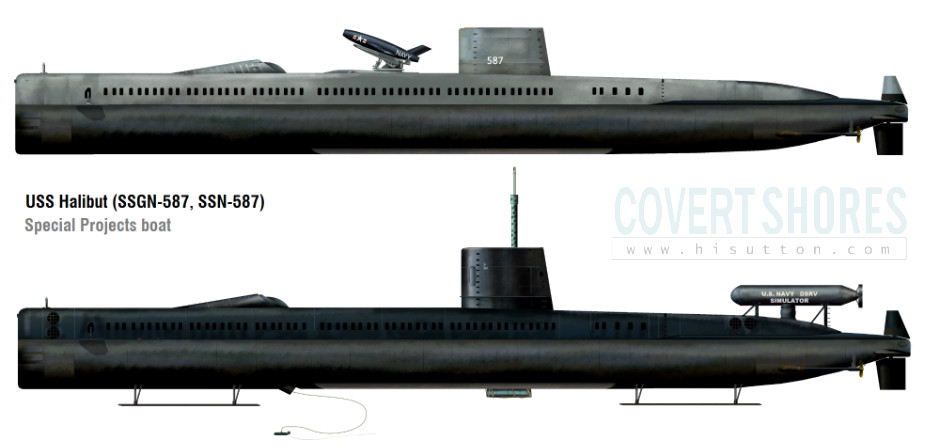
Original Artwork. CLICK for HIGH-RESOLUTION image.
In 1965, within 5 years of entering service as a nuclear deterrence missile submarine, the USS Halibut was already outmoded and surplus to requirements. This was when she was converted into a secret spy submarine. With the passing of time there are many accounts of her operations under the Sea of Okhotsk (most from the excellent book Blind Man's Bluff), but official details remain scarce. She was modified with a well for two remotely-operated undersea drones beneath the hangar which was itself turned into a dedicated space for the intelligence personnel and their massive computer. The Hangar became known as the Bat Cave for obvious reason. A cylinder was added over the rear hatch for elite USN divers. Skids were added to the bottom of the hull and larger anchors were fitted. Thrusters helped keep her in position.
Get The essential guide to World Submarines
This Covert Shores Recognition Guide Covers over 80 classes of submarines including all types currently in service with World Navies.Check it out on Amazon
IVY BELLS
Halibut is most famous for performing the first wire-tap on the Soviet military's undersea communication cables in the Sea of Okhotsk in 1970. The Soviet Navy considered this as its own private sea in the Pacific and it was heavily guarded. The missions were known as IVY BELLS

Sea of Okhotsk, a Soviet Bastion
The tap itself was a large cylinder which had to be put in place by divers operating from the hovering submarine which was anchored to the sea floor.
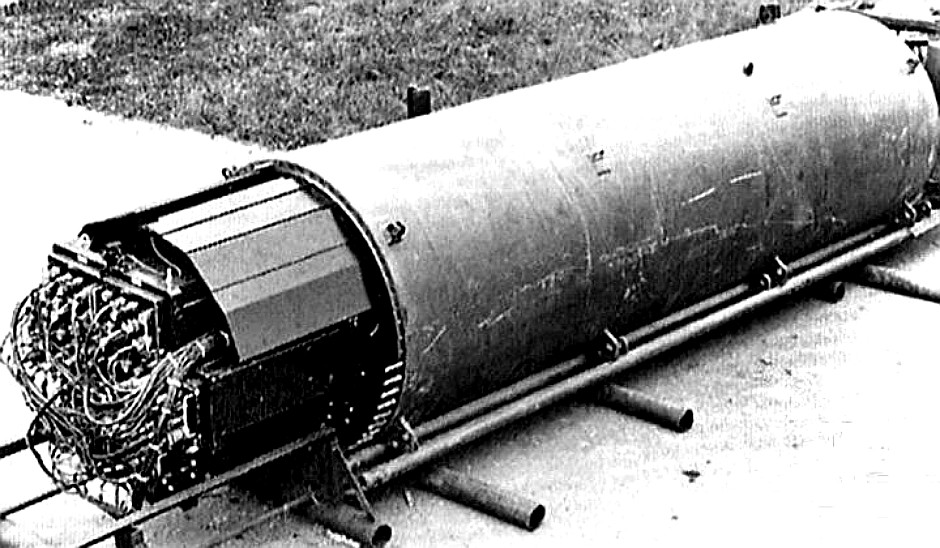
Representative bug. This example is a later model captured by the Soviets. Obviously photos of Halibut's bug are hard to come by!
Original artwork - CLICK for HIGH-RESOLUTION image. 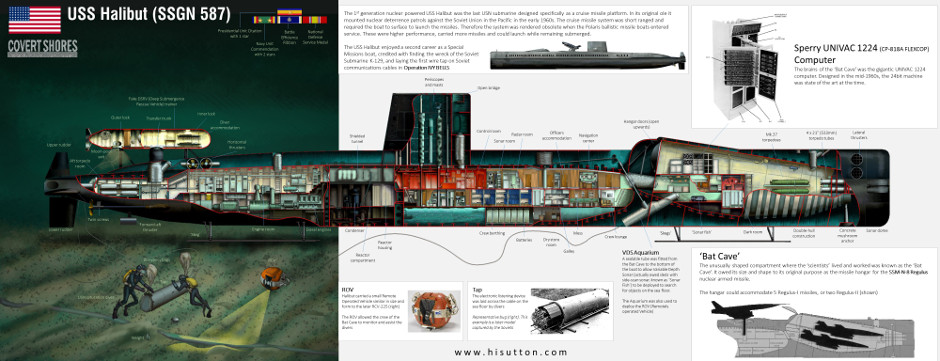
There were many technical innovations and developments which enabled Halibut to perform its Top Secret missions. Key to IVY BELLS' success were the USN Divers who lived in the pressure cylinder mounted above the rear torpedo room. It was designed to look like a dummy Deep Submergence Rescue Vehicle(DSRV) and the cover story was that it was a training device for DSRVs. Normally when divers are operating a great depths they have to depressurize every time they come to the surface, and if they come up too fast they get the bends. This takes up time and is ALWAYS dangerous. So the USN developed a way to keep the divers at deep sea pressures for days on end so that they only had to depressurize once. Also key to their survival was that they breathed a mixed gas rather than air or pure oxygen. This 'Saturation diving' was developed secretly at SEALAB (see below).
The Westinghouse Mk-11 'Abalone' rebreather was worn on the back and enabled divers to operate deeper than regular breathing apparatus. The specialized MH-11 helmet was made by Kirby-Norman.
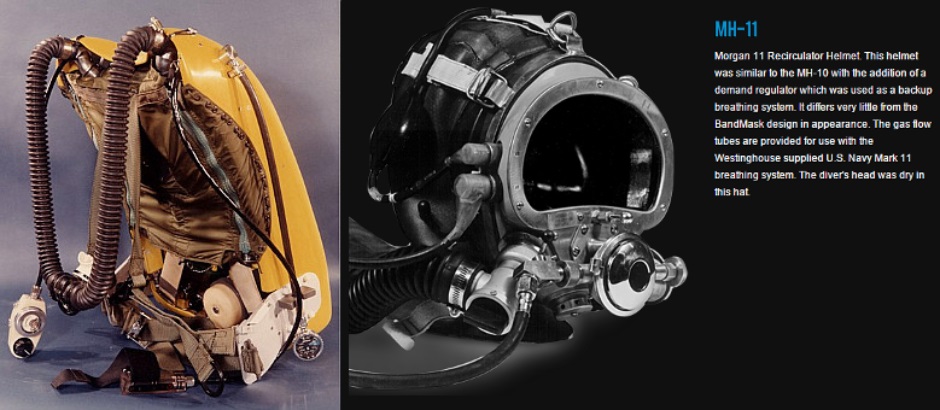
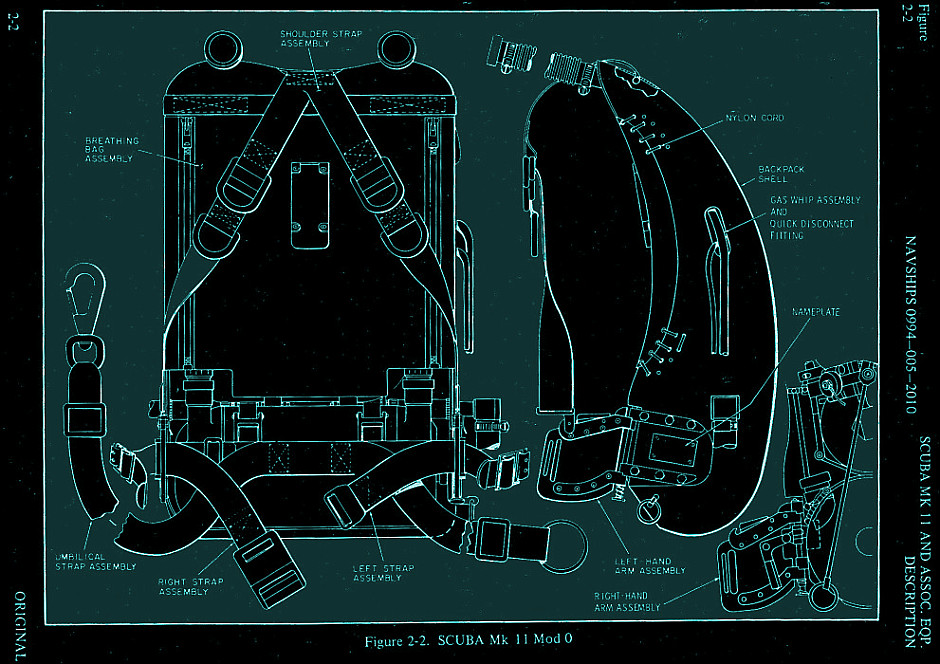
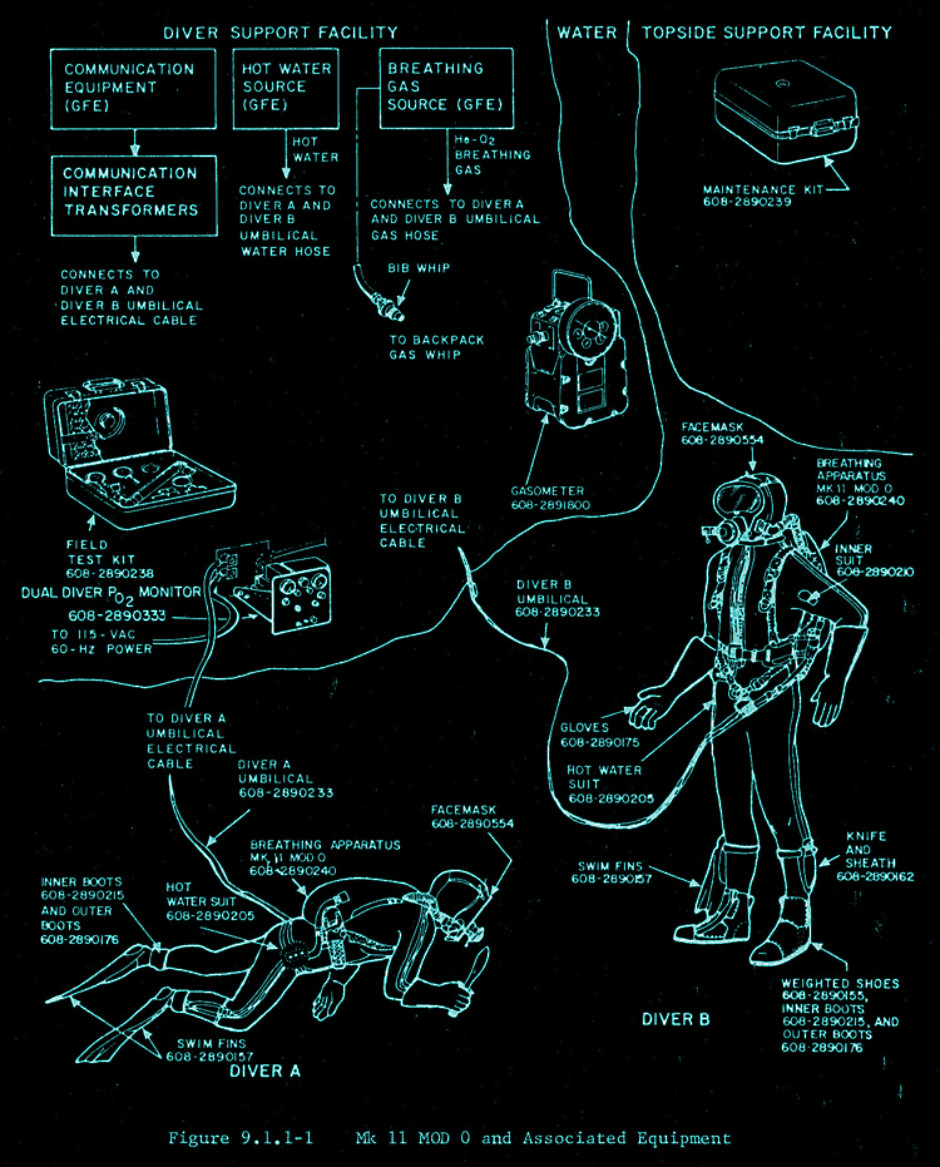

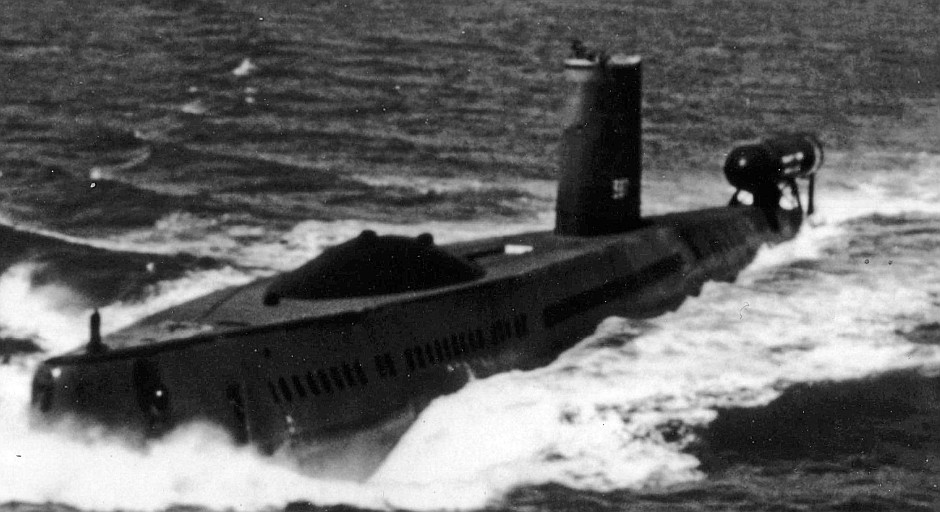
Real DSRV (top) and Halibut's fake DSRV...
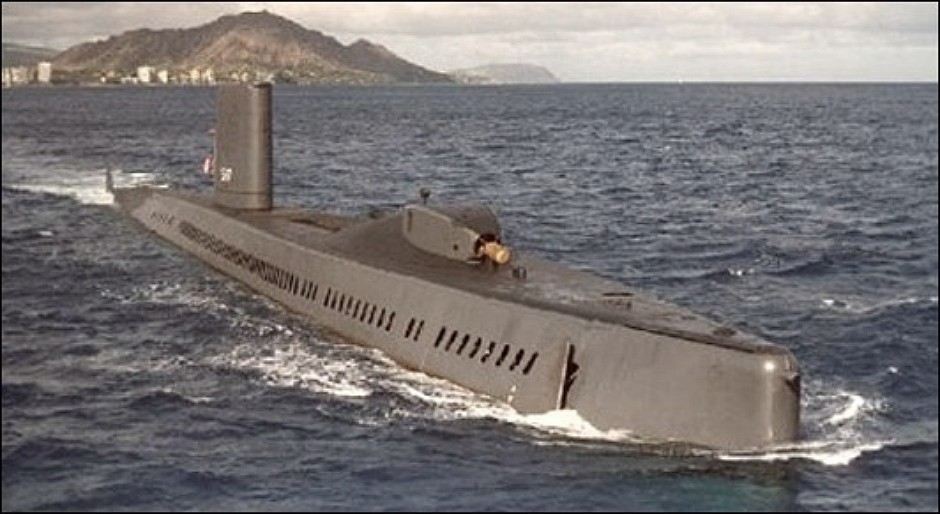
As first modified in 1965 she had an externally mounted thruster (forward of hangar door) and no diver cylinder. The thruster was removed when the cylinder was added.
Missile boat
In the early days of nuclear deterrence USS Halibut was the only nuclear powered submarine designed to launch nuclear cruise missile. She was something of an oddball, an ugly duckling, with the missiles being carried in a cavernous hanger which took up the entire forward section of the submarine. This meant that she had to surface to fire her five Regulus missiles. She was constructed at the juncture between the 'old style' submarines which had hulls shaped for surface running and the newer 'Albacore hulled' boats with rounded bows and pointed sterns for high underwater speed. Her hull was therefore somewhat old-school, although like other boats of her generation it incorporated many hydrodynamic advances over the boats of WW2. And despite this she was, for a brief moment in time, the most awesome and powerful submarine in operational service anywhere in the world. But then came along the Polaris missile submarines with their sleek hulls and sixteen longer ranged missiles which could be launched from under the sea, and she was obsolete in an instance.

CLICK for HIGH-RESOLUTION image. Schematic of Halibut as she was designed. The missiles are Regulus-II but she was in fact only deployed with the smaller Regulus-I. Note the massive hanger which incorporates the torpedo room.
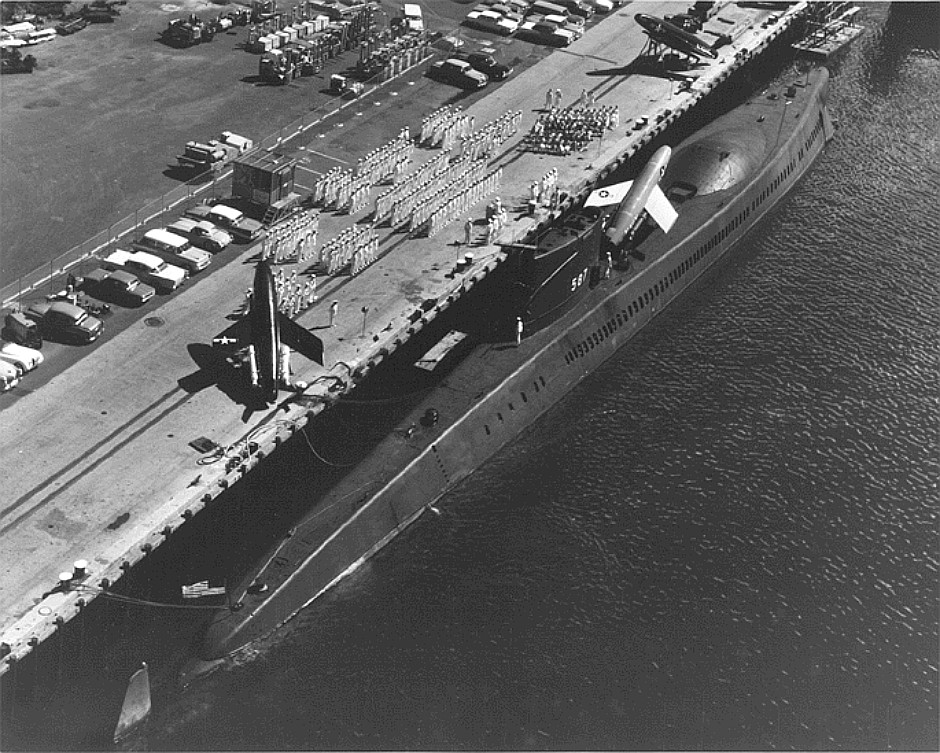
Halibut on display with Regulus-I missiles

Halibut test-fires a Regulus-I cruise missile.
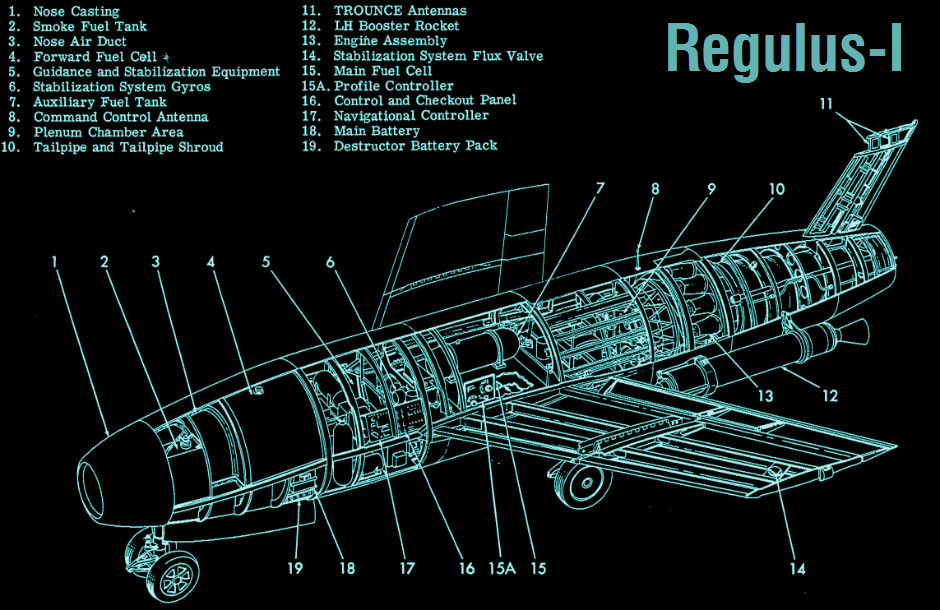
The Regulus-I cruise missile was as lage as a small plane and had to be folded to fit inside the submarine. It owed a lot to the German WW2 V-1 flying bomb. Five could be carried inside the massive hangar.
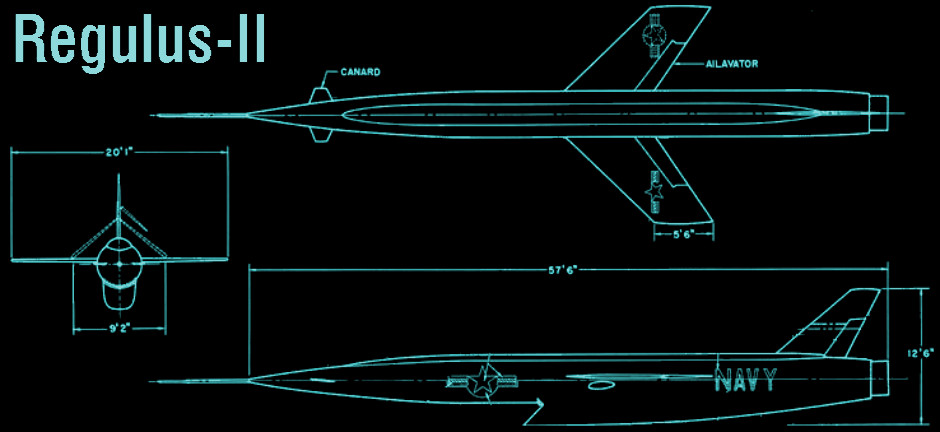
The Regulus-II cruise missile was even larger. Only two could be carried. It was cancelled when the Polaris program proved successful
The ultimate book of Special Forces subs Covert Shores 2nd Edition is the ONLY world history of naval Special Forces, their missions and their specialist vehicles. SEALs, SBS, COMSUBIN, Sh-13, Spetsnaz, Kampfschwimmers, Commando Hubert, 4RR and many more.
Check it out on Amazon
Specification
Displacement: 3,655 tons surfaced, 5,000 tons submerged
Length: 350ft (110m)
Beam: 29ft (8.8m)
Propulsion: S3W reactor, 7300 shp; two turbines, two shafts[1]
Speed: 15kts surfaced, 20kts submerged (before refit), after refit.... much slower
Complement: ~90-100 men including 'civilian' technicians and divers
Armament:
5 x Regulus I nuclear cruise missiles (removed 1965)
4 × 21" (533 =mm) torpedo tubes in bow
2 x 21" (533mm) short torpedo tubes in stern
SEALAB
Ostensibly SEALAB was a scientific experiment with civilian relevance, including for space exploration. This was partly true, but hidden within the civilian justification was other top secret research: saturation diving for covert intelligence missions. SEALABs were underwater habitats positioned of the Florida coast where divers lived at deep sea pressure for up to weeks on end. It was closed after an accident but its legacy lived on.
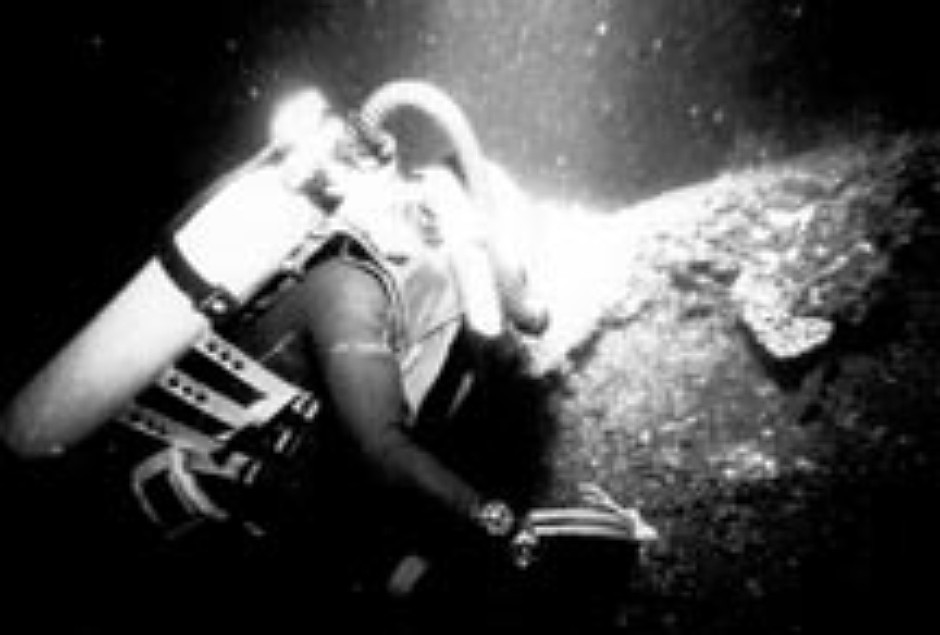
Master Diver Bob Sheats diving at 300f (100m) during SEALAB-II project in 1965 - USN.

SEALAB illustration - USN.
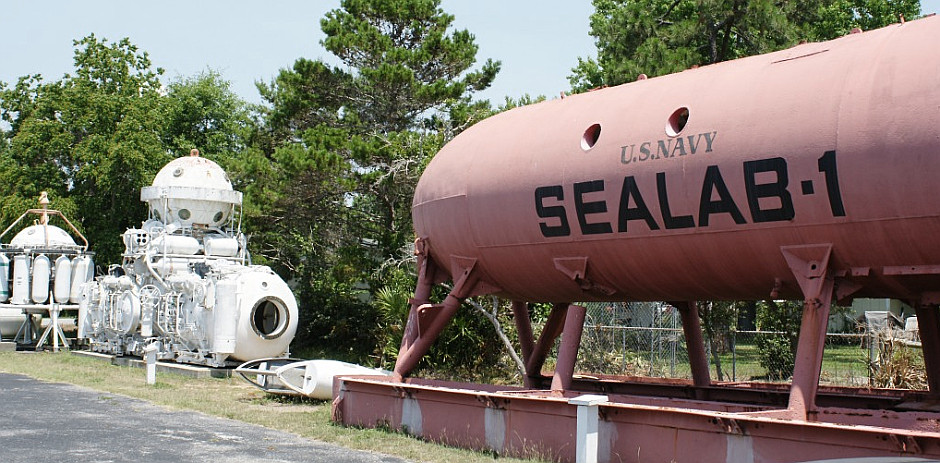
Today the best place to see or learn about SEALAB is the Man in the Sea museum, Florida LINK
Good link I found whilst researching this article About Subs - Halibut
Related articles (Full index of popular Covert Shores articles)

 USS Jimmy Carter (SSN-23) Special Mission submarine
USS Jimmy Carter (SSN-23) Special Mission submarine

 USS Parche spy sub par-excellence. w/Cutaway
USS Parche spy sub par-excellence. w/Cutaway

 USS Seawolf (SSN-575)
USS Seawolf (SSN-575)

 AN-1 submarine aircraft carrier
AN-1 submarine aircraft carrier

 SMX-31 future submarine concept ('The Electric') w/Cutaway
SMX-31 future submarine concept ('The Electric') w/Cutaway

 Project 885 'YASEN' (Severodvinsk Class) SSGN. w/Cutaway
Project 885 'YASEN' (Severodvinsk Class) SSGN. w/Cutaway

 Sturgeon Class SSN. w/Cutaway
Sturgeon Class SSN. w/Cutaway

 Unbuilt US Navy spy submarine
Unbuilt US Navy spy submarine

 USS Grayback Special Forces host submarine
USS Grayback Special Forces host submarine

 NR-1
NR-1

 BS-64 Podmoskovye Special Mission (spy) Host Submarine
BS-64 Podmoskovye Special Mission (spy) Host Submarine

 Project 09852 Belgorod Special Mission submarine (spy sub). w/Cutaway
Project 09852 Belgorod Special Mission submarine (spy sub). w/Cutaway

 Harpsichord AUV
Harpsichord AUV

 Russian unbuilt spy submarine MPS
Russian unbuilt spy submarine MPS

 Russian Losharik spy sub
Russian Losharik spy sub

 Russian Seismic Survey sub
Russian Seismic Survey sub

 Project 1910 UNIFORM Class deep diving spy sub
Project 1910 UNIFORM Class deep diving spy sub

 Russian X-RAY Class spy sub
Russian X-RAY Class spy sub


